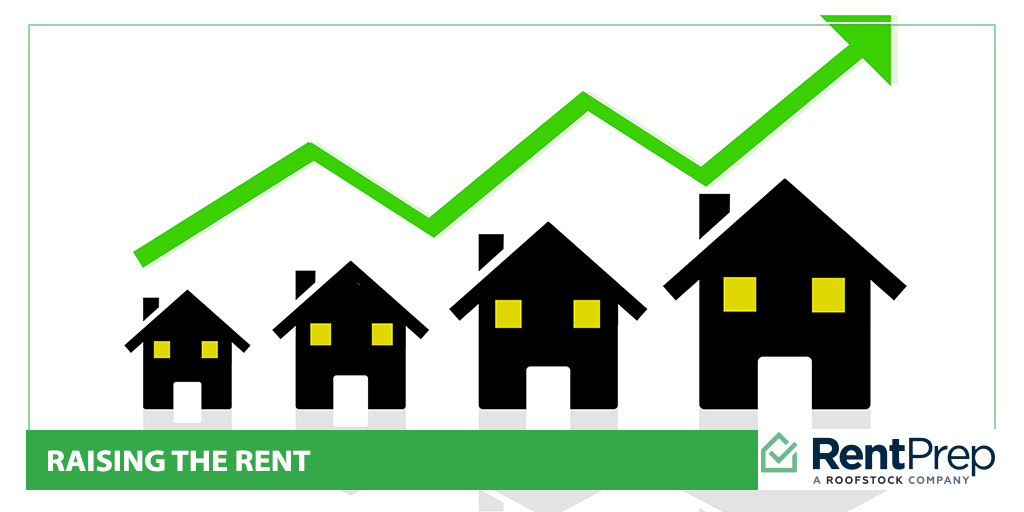
Updated September 2023
In today’s competitive rental market, it’s common for landlords to raise the rent on their properties periodically. While setting the right rent to attract tenants and maximize value is challenging, the bigger hurdle is often discussing and implementing this rent increase with your tenants.
Tenants will often question why their rent is being raised. They may feel it’s a form of retaliation or discrimination, both of which are illegal. And there could be doubts about the fairness and legality of the rent increase. As the landlord, you’ll need to proceed cautiously, to ensure you stay within the limits of the law.
In this article, we’ll offer guidance on how to determine the right amount of rent for your property. We’ll also delve into restrictions governing when and how much landlords can raise their rent and under what circumstances.
Finally, we’ll address the challenge of broaching the subject of rent increases with tenants in a way that nurtures a positive landlord-tenant relationship.
Table Of Contents: A Landlord’s Guide To Raising Rent
There are many factors to consider when deciding to raise the rent on one of your properties. Find advice on all the things that you need to consider in the sections below.
- How To Raise Rent On A Tenant
- Establishing Rent For A Vacant Property
- Raising The Rent With Existing Tenants
- When Can A Landlord Raise Rent?
- Red Flags In Raising The Rent
- Rent Raising FAQs
- Can a landlord raise rent after the lease expires?
- How do you notify a tenant of a rent increase?
- How do you explain a rent increase to a tenant?
- Does an increase in rent increase your security deposit?
- How much can a landlord legally raise rent in New York?
- How do tenants qualify for rent control in New York?
- Raise The Rent The Right Way And Reap The Benefits
How To Raise Rent On A Tenant

Determining the right level or rent for a property can be one of the most challenging tasks for a landlord. You don’t want to charge so much that you make it difficult to attract and keep good tenants, but you want to charge enough to reflect the value of the property and maximize revenue.
Understanding the local rental market and how much rent is being charged for similar properties is an essential first step in the decision making process. But you also need to consider what makes your property unique and could justify a higher rent. Things such as an extra bathroom and proximity to public transportation, for example, can make a major difference when it comes to the rental value of your property.
Tools such as Zillow are useful for assessing the rental market in the surrounding area as you can see how much landlords are currently asking for similar properties. You can also enter your property details into their system and Zillow will provide an estimate of how much your property would rent for.
When assessing your local rental market, consider the following tips:
- Get at least 5 other rental amounts as close to your rental property as possible, preferably on the same block.
- Look at rentals that most closely match your rental property’s features, such as the same number of bedrooms, bathrooms, parking, square footage, and so forth.
- Use rentals that are approximately the same age as your property, within just a few years.
- Find comparisons for rental properties that best match the structure and style of your property, such as a multi-unit property, duplex, or single-family home.
- Compare rental properties that have the same visual appeal as yours, such as similar landscaping, outdoor amenities like a pool or swing set, and so forth.
Take the time to look at the details of the comparable rental properties yourself. Online tools won’t be able to tell you that one property has a higher rent than another because it has a recently remodeled bathroom compared to a pastel relic from the 1960s.
Establishing Rent For A Vacant Property
The easiest time to change your rental price is when the property is vacant. This may also be when you’ve chosen to make renovations and improvements to boost your revenue. When you start marketing the property, you can publish with the new, higher rate. Reactions to your ads will help you understand if you have set the rent at the right level.
- If you’re getting few or no calls from interested renters, it may be that you’ve estimated too high and people are not finding that your advertised price is equal to the description of the property. Fight the urge to drop the advertised rent too soon and instead focus on ways to adjust your description to paint a clearer picture of the property. This way, interested parties will more closely match the rent with the property and give you a call. You may also want to review and even expand your advertising platforms to reach more people.
- If you get a lot of calls and appointments to see the property, but visitors are turning away after viewing it, you may have an issue with the property itself. In other words, the price may be in line with the advertised description, but the actual property doesn’t equal the rental rate. Since you’ve determined that people are at least willing to look at a unit at that rate, it may be time to make some improvements.
- If you’re getting flooded with phone calls and have several applicants vying for the property, that may seem like good news, but you have to wonder if you’ve set the rent a little too low for the market rate. Consider a rent increase after the new lease is up.
Avoid the urge to drop the rent if you don’t get a qualified applicant within a week or so. It can take time for advertising to penetrate the market and attract potential tenants looking for specific things rather than just the cheapest properties in the area.
If you’ve put maximum effort into your research, making your property the best it can be, and done your best marketing, yet you still don’t get the responses you’re hoping for, it’s time to carefully lower the advertised rental rate.
Raising The Rent With Existing Tenants
When you and your current tenant sat down to sign the lease agreement, it clearly specified the amount of rent due each month, plus the term of the lease. This means that you cannot raise the rent during the term of the agreement. If they signed a one-year lease, you need to wait until that period has expired to raise the rent. But you can raise the rent if the tenant wishes to stay on as part of negotiating a new lease.
Check your state law for how much notice you need to give a tenant before raising their rent. Most states require between 30 and 60 days notice. Some states also regulate the percentage that landlords can raise the rent after a lease has expired, so get familiar with the applicable laws in your state before acting.
For example, New York City sets the rent increase limit at 3.5% at the end of a one-year lease agreement and 5% at the end of a two-year lease agreement. In California, at the end of a 12-month lease, landlords can raise the rent a maximum of 10%, or 5% plus the cost of living increase, whichever is lower. In Texas, there is no limit on how much rent can be raised.
If the lease is nearing expiration and you intend to raise the rent, take the following steps:
- Make sure your rental increase notice is delivered in plenty of time and in compliance with your state laws.
- Put the information in an official written notice to the tenant that includes the new rental amount and the date it becomes effective. This can be a signed and dated letter, or you can download a form online.
- Keep a copy of the notice for your records.
- Send the official notice of rent increase to the tenant via certified mail.
- As a courtesy, send the tenant a follow-up email, letter, or phone message reminding them of the new rent right before it’s due for the first time.
Be prepared for the tenant to get a little upset at the rent increase. They’ll probably contact you to negotiate. Of course, remain professional and explain that you need to keep up with the current rental market rates and that you hope they will stay.
Your tenant may choose not to renew the lease and start looking for another place. Keep the lines of communication open so that you end the lease term in a ways that benefits both of you.
If your tenant is choosing to renew the lease agreement with the new rent for another year, make sure the new rental amount is reflected in the new lease.
If the tenant is on a month-to-month agreement where there is no written lease, or the expired year lease has turned into a month-to-month tenancy, you can raise the rent at any time after giving a 30-day notice. Follow the same procedure and always keep track of notices and any email or text conversations for your records.
When Can A Landlord Raise Rent?

Landlords can usually only raise rent at the end of a rental contract. This is when the current financial agreement has expired and the landlord and tenant are entering into a new lease. Many states have specific rules for how much the rent can be raised at this time.
Landlords cannot raise the rent mid-contract, except in special circumstances. For example, a rental contract may have a specific clause that allows for a mid-contract rent increase. This is more common for long-term rental contracts than a one-year lease agreement.
If you have a rolling month-by-month rental contract, the landlord can raise the rent at the end of any month as long as sufficient notice is given under state law. Some states also have laws about how often rents can be raised—for example, only once a year.
Red Flags In Raising The Rent
Landlords are not allowed to raise the rent if it’s done as a result of discrimination or retaliation. If you’re planning to increase the rent, make sure you’re doing it for the right reason and can document that reason in case of a future conflict with your tenant.
Even the appearance of raising the rent as discrimination or retaliation can land you in court, even if you didn’t mean it that way or never even considered the possibility.
Discrimination
Raising the rent as a result of discrimination may happen if something has changed or you recently discovered something related to the tenant’s gender, race, national origin, religion, disability, or familial status.
Some states and municipalities also include age, sexual orientation, and other protections in this definition of discrimination. It can look like discrimination if you send a notice for a rent increase shortly after being made aware of something or there is evidence of some change with the tenant or tenant’s family.
An example might be if a tenant has a baby and the landlord implements a rent increase shortly thereafter. Another example might be that a landlord discovers a tenant is gay and raises the rent in order to force the tenant to move. To stay within the law, make sure your rent increases are moderate and are not connected to any sort of discrimination or desire to force the tenant out.
Retaliation
Raising the rent as retaliation can take place when a landlord tries to force a tenant out for exercising their rights, such as asking for repairs or performing certain actions as a tenant. An example of this might be if a tenant reports a building code violation in the rental property to the local regulatory agency, who then takes action. Another example is if a tenant forms a tenants’ rights group within a multi-unit community to better enact change with the management.
Many courts automatically assume any rent increase within six months of such actions is retaliatory. Make sure that if your tenant has done anything like these examples, you don’t raise the rent shortly after or do so in order to get revenge or make them leave.
Rent Raising FAQs
Can a landlord raise rent after the lease expires?
This is a common question renters ask when the notice arrives that the rent is going up.
The answer is that, yes, a landlord has the right to raise the rent after the lease expires. The landlord does not have the right to raise rent during a lease as that would be a violation of the contract.
There is another situation where a landlord cannot raise the rent. If it is a rent-controlled area or a property that’s part of the Housing Choice Voucher program (Section 8), there are caps on how much a landlord can charge for rent.
How do you notify a tenant of a rent increase?
You should notify a tenant officially in writing of the rental increase 30-60 days before the proposed date as dictated by your state law. This gives the tenant the opportunity to consider if they want to stay in the property with the higher rent or look for a new place to live.
If you are signing a new rental agreement, make sure the new rent is reflected in the lease. If the tenant is on a rolling month-by-month contract, keep all communications as a record of the change. This includes both your letter advising the tenant of the increase and their confirmation of their intention to continue to rent the property at the new, higher rate.
How do you explain a rent increase to a tenant?
Tenants will often have questions when they’re advised of a rent increase. They will be especially curious if they suspect that it may be a response to something they’ve done, such as recently complaining or having a baby.
It’s valuable to be able to explain your reasoning behind the rent increase. Let the tenant know how long it’s been since the rent increased and how you’ve raised the rent in line with other local rents and inflation.
Does an increase in rent increase your security deposit?
Since security deposits are usually calculated as a multiple of the monthly rent, an increase in monthly rent also leads to a corresponding increase in the security deposit. You can ask the tenant to provide the additional funds as part of the next month’s rent.
However, if the rent increase is substantial, it’s good practice for landlords to negotiate with tenants and allow them to pay toward the additional security deposit over a period of months. The landlord can also choose not to increase the security deposit for a trusted, long-term tenant.
How much can a landlord legally raise rent in New York?
As of June 2022, New York City law states that rent can be increased by 3.25% after a one -year lease or 5% after a two-year lease agreement expires. Landlords must give 60-days notice for tenants on a one- or two-year lease, and 90 days for a tenant who has lived in the property for more than two years.
How do tenants qualify for rent control in New York?
In New York, rent control usually only applies to buildings built before February 1, 1947, and for tenants that have been in continued occupancy since before July 1, 1971. Rent controlled departments operate under the Maximum Base Rent system, which is adjusted every two years to reflect operating costs.
Tenants who live in buildings of six or more units built before January 1, 1974, usually enjoy rent stabilization. Counties set rules annually for how much stabilized rents can be raised.
Raise The Rent The Right Way And Reap The Benefits
It’s completely acceptable for landlords to raise their rents in line with market values to maximize their profit on a regular basis. But you also need to stay within the limits of the law when it comes to when and how often you raise the rent, how much you raise the rent, and what justification you have for the increase.
Landlords can’t raise the rent to try and force someone out of the property, but only as a justified increase to maximize profits within reasonable market and legal limits.
While it’s always easiest to increase rent between tenants, if you’re raising rent for an existing tenant, the best approach is to be open and transparent about the legal process and why the rent is being raised. Keep a detailed record to demonstrate that you have done things the right way.
What are some tips, tricks, and strategies you use in raising the rent at your rental properties? Please share this article and let us know in the comments below.

